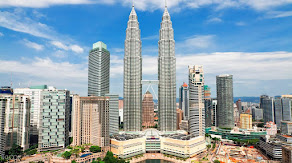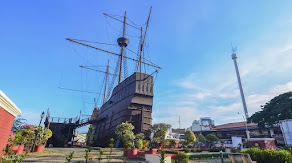
Malaysia implements duty free but control economy system. In this economic system any individual or organisation is free to carryout whatever economic activities as long as they are not going against the rules. However, there are certain sectors that are still under control by the government such Health Education Services, Welfare, Rescue Unit and others to look after the important thing of the country and civilian generally. As an alternative institution such as private Education, private Hospital and others are still been implemented.
In the year 2000, Malaysia KDNK is 85 billion. This rate mean increases before Malaysia faced the downfall of the economic in the year 1997 that is about 8% per year. In the year 2003, Malaysia mean is expected to increase as much as 3%. Malaysia consumer price index in the year 2000 is 1.5. Malaysia per capital GNI (Current prices) (RM) is about RM 12,000.
After the year 1980’s, the economy will gradually change from depending to the raw commodity such as rubber, oil palms and cocoa rubber to the type of industrial economy. Ever since 1990’s, the main contribution to Malaysia KDNK is through electronic industry, tourism and others.
However, the economic sector is important and is being preserve to decrease the clinging to the specifically imported raw commodity as to become an alternative if Malaysia ever face problems in the industrial field. Therefore it contributes to the existence of industrious economic system. Malaysia is among the world’s largest producers of rubber, tin, palm oil, timber, pepper and petroleum. Tourism, too, is emerging as a major revenue earner.
In the year 2000, Malaysia KDNK is 85 billion. This rate mean increases before Malaysia faced the downfall of the economic in the year 1997 that is about 8% per year. In the year 2003, Malaysia mean is expected to increase as much as 3%. Malaysia consumer price index in the year 2000 is 1.5. Malaysia per capital GNI (Current prices) (RM) is about RM 12,000.

After the year 1980’s, the economy will gradually change from depending to the raw commodity such as rubber, oil palms and cocoa rubber to the type of industrial economy. Ever since 1990’s, the main contribution to Malaysia KDNK is through electronic industry, tourism and others.
However, the economic sector is important and is being preserve to decrease the clinging to the specifically imported raw commodity as to become an alternative if Malaysia ever face problems in the industrial field. Therefore it contributes to the existence of industrious economic system. Malaysia is among the world’s largest producers of rubber, tin, palm oil, timber, pepper and petroleum. Tourism, too, is emerging as a major revenue earner.
Malaysia is a growing and relatively open economy. In 2007, the economy of Malaysia was the 29th largest economy in the world by purchasing power parity with gross domestic product for 2007 was estimated to be $357.9 billion with a growth rate of 5% to 7% since 2007. The Southeast Asian nation experienced an economic boom and underwent rapid development during the late 20th century and has a GDP per capita of $14,400, being considered a newly industrialized country. On the income distribution, there are 5.8 million households in 2007. Of that, 8.6% have an monthly income below RM1,000, 29.4% had between RM1,000 and RM2,000, while 19.8% earned between RM2,001 and RM3,000; 12.9% of the households earned between RM3,001 and RM4,000 and 8.6% between RM4,001 and RM5,000. Finally, around 15.8% of the households have an income of between RM5,001 and RM10,000 and 4.9% have an income of RM10,000 and above.As one of three countries that control the Strait of Malacca, international trade plays a large role in its economy.[5] At one time, it was the largest producer of tin, rubber and palm oil in the world. Manufacturing has a large influence in the country's economy 
Since it became independent, Malaysia's economic record has been one of Asia's best. Real gross domestic product (GDP) grew by an average of 6.5% per year from 1957 to 2005. Performance peaked in the early 1980s through the mid-1990s, as the economy experienced sustained rapid growth averaging almost 8% annually. High levels of foreign and domestic investment played a significant role as the economy diversified and modernized. Once heavily dependent on primary products such as rubber and tin, Malaysia today is a middle-income country with a multi-sector economy based on services and manufacturing. Malaysia is one of the world's largest exporters of semiconductor devices, electrical goods, and information and communication technology (ICT) products.
The government continues to actively manage the economy. Malaysia's New Economic Policy (NEP), first established in 1971, was a 10-year plan that sought to rectify a situation whereby ethnic Malays and indigenous peoples (“bumiputera”), who comprised nearly 60% of the population, held less than 3% of the nation’s wealth. Policy makers implemented a complex network of racial preferences intended to promote the acquisition of economic assets by bumiputera. In 1981 when the racial preferences were set to expire, the government extended the NEP for another 10 years, stating that its goals had not been achieved. The policies again were extended in 1991 and in 2001.
The Malaysian economy went into sharp recession in 1997-1998 during the Asian financial crisis, which affected countries throughout the region, including South Korea, Indonesia, and Thailand. Malaysia's GDP contracted by more than 7% in 1998. Malaysia narrowly avoided a return to recession in 2001 when its economy was negatively impacted by the bursting of the dot-com bubble (which hurt the ICT sector) and slow growth or recession in many of its important export markets.
In July 2005, the government removed the 7-year old peg linking the ringgit's value to the U.S. dollar at an exchange rate of RM 3.8/U.S. $1.0. The dollar peg was replaced by a managed float against an undisclosed basket of currencies. The new exchange rate policy was designed to keep the ringgit more broadly stable and to avoid uncertain currency swings which could harm exports. The Malaysian financial system has exhibited noteworthy resilience to the 2008 global financial crisis. Malaysian banks are well capitalized and have no measurable exposure to the U.S. sub-prime market. The central bank maintains high levels of foreign exchange reserves and a conservative regulatory environment, having prohibited some of the riskier assets in vogue elsewhere. However, decreasing demand in the U.S. and elsewhere is taking a toll on Malaysian exports, resulting in slower economic growth going forward.
The new exchange rate policy was designed to keep the ringgit more broadly stable and to avoid uncertain currency swings which could harm exports. The Malaysian financial system has exhibited noteworthy resilience to the 2008 global financial crisis. Malaysian banks are well capitalized and have no measurable exposure to the U.S. sub-prime market. The central bank maintains high levels of foreign exchange reserves and a conservative regulatory environment, having prohibited some of the riskier assets in vogue elsewhere. However, decreasing demand in the U.S. and elsewhere is taking a toll on Malaysian exports, resulting in slower economic growth going forward.

Since it became independent, Malaysia's economic record has been one of Asia's best. Real gross domestic product (GDP) grew by an average of 6.5% per year from 1957 to 2005. Performance peaked in the early 1980s through the mid-1990s, as the economy experienced sustained rapid growth averaging almost 8% annually. High levels of foreign and domestic investment played a significant role as the economy diversified and modernized. Once heavily dependent on primary products such as rubber and tin, Malaysia today is a middle-income country with a multi-sector economy based on services and manufacturing. Malaysia is one of the world's largest exporters of semiconductor devices, electrical goods, and information and communication technology (ICT) products.
The government continues to actively manage the economy. Malaysia's New Economic Policy (NEP), first established in 1971, was a 10-year plan that sought to rectify a situation whereby ethnic Malays and indigenous peoples (“bumiputera”), who comprised nearly 60% of the population, held less than 3% of the nation’s wealth. Policy makers implemented a complex network of racial preferences intended to promote the acquisition of economic assets by bumiputera. In 1981 when the racial preferences were set to expire, the government extended the NEP for another 10 years, stating that its goals had not been achieved. The policies again were extended in 1991 and in 2001.
The Malaysian economy went into sharp recession in 1997-1998 during the Asian financial crisis, which affected countries throughout the region, including South Korea, Indonesia, and Thailand. Malaysia's GDP contracted by more than 7% in 1998. Malaysia narrowly avoided a return to recession in 2001 when its economy was negatively impacted by the bursting of the dot-com bubble (which hurt the ICT sector) and slow growth or recession in many of its important export markets.
In July 2005, the government removed the 7-year old peg linking the ringgit's value to the U.S. dollar at an exchange rate of RM 3.8/U.S. $1.0. The dollar peg was replaced by a managed float against an undisclosed basket of currencies.
 The new exchange rate policy was designed to keep the ringgit more broadly stable and to avoid uncertain currency swings which could harm exports. The Malaysian financial system has exhibited noteworthy resilience to the 2008 global financial crisis. Malaysian banks are well capitalized and have no measurable exposure to the U.S. sub-prime market. The central bank maintains high levels of foreign exchange reserves and a conservative regulatory environment, having prohibited some of the riskier assets in vogue elsewhere. However, decreasing demand in the U.S. and elsewhere is taking a toll on Malaysian exports, resulting in slower economic growth going forward.
The new exchange rate policy was designed to keep the ringgit more broadly stable and to avoid uncertain currency swings which could harm exports. The Malaysian financial system has exhibited noteworthy resilience to the 2008 global financial crisis. Malaysian banks are well capitalized and have no measurable exposure to the U.S. sub-prime market. The central bank maintains high levels of foreign exchange reserves and a conservative regulatory environment, having prohibited some of the riskier assets in vogue elsewhere. However, decreasing demand in the U.S. and elsewhere is taking a toll on Malaysian exports, resulting in slower economic growth going forward.






